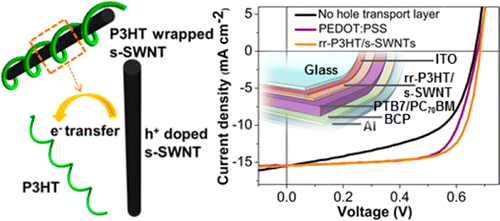 An organic solar cell is a type of polymer solar cell that uses organic electronics for light absorption and charge transport to produce electricity from sunlight by the photovoltaic effect. The plastic used in organic solar cells has low production costs in high volumes and is therefore appealing for photovoltaic applications.
An organic solar cell is a type of polymer solar cell that uses organic electronics for light absorption and charge transport to produce electricity from sunlight by the photovoltaic effect. The plastic used in organic solar cells has low production costs in high volumes and is therefore appealing for photovoltaic applications.
In the field of Organic Photovoltaics (OPVs), carbon nanotubes (CNTs) have been identified as promising candidates for numerous usages in the solar cell such as excitonic antennas and high mobility charge extraction paths. In a recent study, our 90% pure semiconducting ISO-s nanotubes were used as an efficient hole extraction layer (Dabera, G., et. al., ACSNano (2013), 7 (1), pp 556–565.)
Our SWNTs were shown to be a potential substitute for poly(3,4-ethylenedioxythiopene):poly-(styrenesulfonate)(PEDOT:PSS) to reduce degradation of indium tin oxide (ITO), and thereby increase the lifetime of the solar cell.
The solar cell that was made using our IsoNanotubes-S was determined to be the best large area (70mm2) carbon nanotube incorporated solar cell to date, boasting a power conversion efficiency (PCE) of 7.6%
Dye Sensitized Solar Cell
A dye-sensitized solar cell, also called the Grätzel cell, is a low cost thin film solar cell that harnesses sunlight for photoexcitation of electrons to create an electrical current. Nanotubes have attracted a great deal of attention in this field of research to serve as potential replacements for expensive materials, reduce chemical stability problems, and increase conversion efficiency.
Small fractions of nanotubes have been shown to improve power conversion efficiency in Dye-sensitized Solars Cells by increasing electron collection efficiency. Single-walled carbon nanotube-TiO2 nanocrystal core-shell nanocomposites, comprised of our material were used as photoanodes with a Power Conversion Efficiency of 10.6% (Dang et al., Nature Nanotechnology (2011), 6, 377–384).